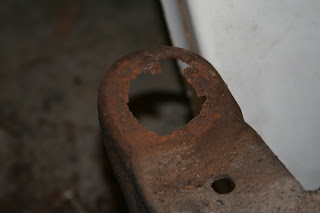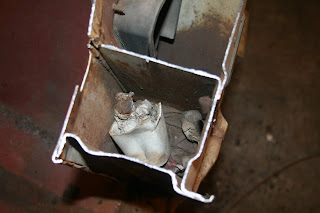This time, I used the sawzall to radially cut outward from the inside. Then, I hit each pie section with the grinder wheel until it could be broken off with the hammer. Making the hole you see below took an entire grinder wheel per side, but I'm happy with the results.



Since this side didn't take up the whole hour this evening that my wife granted me, I moved on to the passenger's side radiator core support mounting place.
 I cut out a large section so that the repair wasn't directly over where the rubber radiator core support mount will be. This is overkill since it will be strong enough, but oh well.
I cut out a large section so that the repair wasn't directly over where the rubber radiator core support mount will be. This is overkill since it will be strong enough, but oh well.
Here's the semi-final repair. I won't drill a hole for the core support mount until I have the other side finished and the core support handy so I can get it right. These holes were originally smaller than the holes for the cab mounts, so there is less margin for error. Once the other side is done, I'll get out the hole saw and drag the core support out of storage for fitment.
 Time expired before I had a chance to do the passenger's side, so I'll have to be happy with tonight's progress. Once I finish that, I'll flip the frame over and weld all the repairs from the bottom side as well. Then, I'll make room for the Crown Victoria front suspension and stack the frame against the wall to make room in the garage for the wife's car. Winter is fast approaching.
Time expired before I had a chance to do the passenger's side, so I'll have to be happy with tonight's progress. Once I finish that, I'll flip the frame over and weld all the repairs from the bottom side as well. Then, I'll make room for the Crown Victoria front suspension and stack the frame against the wall to make room in the garage for the wife's car. Winter is fast approaching.

















































